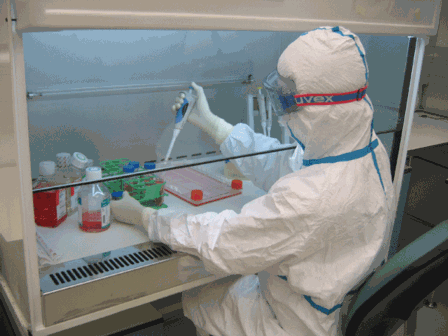 Researchers have engineered mice in which the damage caused by a mutant human TDP-43 protein could be reversed by one type of brain immune cell. TDP-43 is a protein that misfolds and accumulates in the motor areas of the brains of patients with Lou Gehrig’s disease. The results point to new approaches for amyotrophic lateral sclerosis (ALS) therapy.
Researchers have engineered mice in which the damage caused by a mutant human TDP-43 protein could be reversed by one type of brain immune cell. TDP-43 is a protein that misfolds and accumulates in the motor areas of the brains of patients with Lou Gehrig’s disease. The results point to new approaches for amyotrophic lateral sclerosis (ALS) therapy.
The selective demise of motor neurons is the hallmark of Lou Gehrig’s disease ALS. Yet neurologists have suspected there are other types of brain cells involved in the progression of this disorder—perhaps protection from it, which could light the way to treatment methods for the incurable disease.
First author Krista J Spiller and senior author Virginia M-Y Lee (both Center for Neurodegenerative Disease Research, University of Pennsylvania, Philadelphia, USA), along with a professor of Pathology and Laboratory Medicine, published their findings in Nature Neuroscience.
They found that microglia, the first and primary immune response cells in the brain and spinal cord, are essential for dealing with TDP-43-associated neuron death. This study is the first to demonstrate how healthy microglia respond to pathological TDP-43 in a living animal.
“The prevailing view in the field has been that immune system inflammation contributes to the death of neurons in ALS, but this study shows the opposite – that microglia are actually critical for neuronal survival,” Lee says.
The number of microglia cells remained stable in mice with ALS symptoms. However, after the researchers chemically suppressed expression of pathological human TDP-43 in the mice, microglia dramatically proliferated and changed their shape and what genes they expressed.
The researchers were perplexed as to why the microglia did not react automatically to the presence of mutant TDP-43 and how subduing its expression incited microglia to react. “This is still a mystery, but one that we’d very much like to figure out in future studies,” Spiller says.
The normally branched microglia retracted their extensions and expanded the size of their main cell bodies. This rapid change in shape is fairly unique to microglia in the central nervous system, although macrophages, microglia’s immune-system counterpart in peripheral parts of the body, are similarly dynamic in their shape shifting.
The now abundant, remade microglia multiplied by 70 percent after one week and selectively cleared accumulated human TDP-43 from motor neurons. Microglia surround TDP-43-filled neurons and turned on genes to make proteins that help them attach to the sick cells and induce a process called phagocytosis that envelops the mutant proteins for disposal. After the mop up, mice stopped exhibiting motor dysfunction symptoms such as leg clasping and tremors, and they regained their ability to walk and gain weight.
Conversely, TDP-43 was not fully cleared in mice with no microglia. When proliferation of microglia was blocked, the mice failed to regain full muscle function, revealing how important microglia are for cleaning up clumps of misfolded proteins.
“The way reactive microglia protect neurons points us towards new ideas for ALS therapies,” Spiller says. “For example, we want to know if we can encourage the expansion of microglia in early-stage ALS patients to save their motor neurons.”







